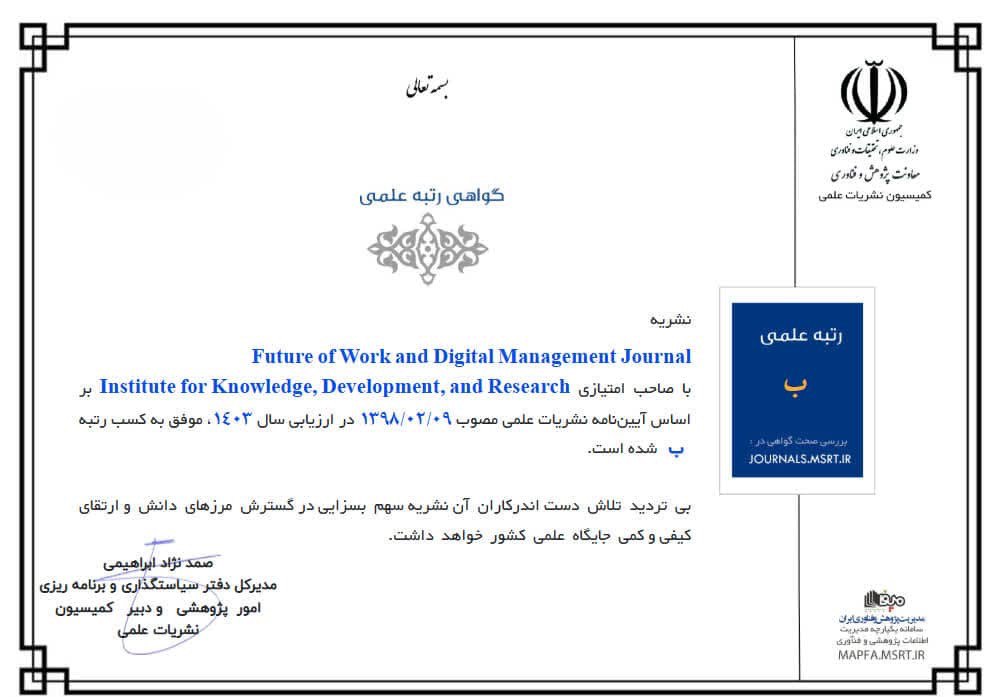Institutional Voids and Regulatory Ambiguity in Platform-Based Work
Keywords:
gig economy, platform work, regulatory ambiguity, institutional voidsAbstract
This study aimed to explore how gig workers in Iraq experience and navigate institutional voids and regulatory ambiguity in platform-based employment. A qualitative research design was employed, using semi-structured interviews with 29 platform-based workers from major cities in Iraq including Baghdad, Basra, Erbil, and Najaf. Participants were selected through purposive sampling to ensure sectoral diversity across ride-hailing, food delivery, and freelance digital services. Data collection continued until theoretical saturation was reached. All interviews were transcribed verbatim and analyzed using thematic analysis in NVivo software, following Braun and Clarke’s six-step approach. The analysis focused on identifying recurring themes related to workers’ legal status, institutional engagement, and adaptive strategies in the absence of formal protections. Three main themes were identified: navigating regulatory uncertainty, institutional disconnection, and adaptive work practices. Workers reported widespread legal ambiguity, including the absence of formal contracts, unclear tax obligations, and inconsistent enforcement by authorities. Participants also expressed mistrust in public institutions and described being excluded from unions, social protection systems, and formal financial services. In response, workers relied on informal networks, self-regulation, and algorithmic management tactics to cope with risk and optimize earnings. Emotional resilience and flexibility were key survival strategies, but often came at the expense of psychological well-being and job stability. The findings highlight that in fragile regulatory environments such as Iraq, platform-based workers operate within profound institutional voids that intensify their precarity. Regulatory ambiguity is not a temporary condition but a structural feature that benefits platforms while disempowering workers. Policy reform, institutional coordination, and platform accountability are urgently needed to support worker rights and stability in the gig economy.
Downloads
References
[1] H. S., "Gig Workers: A Comprehensive Analysis of the Rise, Challenges, and Future of the Gig Economy," International Journal for Multidisciplinary Research, vol. 6, no. 5, 2024, doi: 10.36948/ijfmr.2024.v06i05.29525.
[2] A. Joshi, S. Jain, and P. K. Gupta, "Challenges and Impact of the Gig Economy," Sustain. Econ., vol. 2, no. 2, p. 96, 2024, doi: 10.62617/se.v2i2.96.
[3] S. Ahuja, Y. E. Chan, and A. Sadreddin, "Innovating Within Institutional Voids: A Digital Health Platform in India," 2023, doi: 10.24251/hicss.2023.753.
[4] V. H. K. Wardhana, M. G. Herlina, S. Bangsawan, and M. A. Tuori, "Regulatory Developments in the Gig Economy: a Literature Review," The Winners, vol. 21, no. 2, pp. 141-153, 2020, doi: 10.21512/tw.v21i2.6758.
[5] W. Hoff, "Regulatory Governance for the Gig Economy," Krytyka Prawa, vol. 13, no. 2, 2021, doi: 10.7206/kp.2080-1084.448.
[6] I. I. Udaah, A. Abubakar, and P. J. Frick, "Welfare Effect of Gig Economy on Urban Households in Nigeria," African Journal of Economics and Sustainable Development, vol. 7, no. 4, pp. 203-218, 2024, doi: 10.52589/ajesd-sx6xoomb.
[7] S. Khanal and M. P. Khanal, "Regulating Gig Economy in Nepal: How Can Nepal Benefitted From the Gig Platform?," J. Musikot Campus, vol. 2, no. 1, pp. 173-192, 2024, doi: 10.3126/jmc.v2i1.70844.
[8] J. Gill and S. Gupta, "The Gig Economy and Its Implications on Contract Labor Laws," NJRS, vol. 9, no. 2, 2024, doi: 10.69953/njrs.v9i2.11.
[9] G. Pilatti, F. L. Pinheiro, and A. d. Á. Montini, "Systematic Literature Review on Gig Economy: Power Dynamics, Worker Autonomy, and the Role of Social Networks," Administrative Sciences, vol. 14, no. 10, p. 267, 2024, doi: 10.3390/admsci14100267.
[10] J. Hwang, "The GIG Economy and Its Implications for Labor Laws and Worker Protections," International Journal of Science and Research Archive, vol. 13, no. 1, pp. 3405-3416, 2024, doi: 10.30574/ijsra.2024.13.1.1714.
[11] R. Singh and G. K. Bisen, "Job Related Uncertainty in the Age of Artificial Intelligence and Gig Economy," CRR, vol. 1, no. 1, pp. 85-100, 2023, doi: 10.21844/crr.v1i01.1107.
[12] C. Hux, P. A. Smith, and M. A. Cefaratti, "Accounting for Revenue Recognition in the Gig Economy: An Instructional Case," Issues in Accounting Education, vol. 37, no. 3, pp. 101-123, 2022, doi: 10.2308/issues-2020-040.
[13] G. Nioradze, "Older Workers’ Labor and the Gig-Economy: Precarization or New Opportunities?," Sociological Journal, vol. 28, no. 4, pp. 102-117, 2022, doi: 10.19181/socjour.2022.28.4.9317.
[14] K. Hu and F. Fu, "Evolutionary Dynamics of Gig Economy Labor Strategies Under Technology, Policy and Market Influence," 2021, doi: 10.48550/arxiv.2103.13234.
[15] M. Muhyiddin, N. S. Annazah, H. Tobing, N. Habibi, F. Fauziyah, and R. I. P. Harsiwie, "The Ambiguity of Employment Relationship in Indonesia's Gig Economy: A Study of Online Motorcycle Taxi Drivers," Jurnal Ketenagakerjaan, vol. 19, no. 3, pp. 262-280, 2024, doi: 10.47198/jnaker.v19i3.416.
[16] K. K. P., "Gig Workers: Challenges and Legal Recognition in India," International Journal for Multidisciplinary Research, vol. 6, no. 2, 2024, doi: 10.36948/ijfmr.2024.v06i02.15836.
[17] T. C. Au‐Yeung, C. K. Chan, C. K. K. Ming, and W. Y. A. Tsui, "The Gig Economy, Platform Work, and Social Policy: Food Delivery Workers’ Occupational Welfare Dilemma in Hong Kong," Journal of Social Policy, vol. 54, no. 2, pp. 673-691, 2024, doi: 10.1017/s0047279423000673.
[18] J. Hwang, "The GIG Economy and Its Effects on the Labor Market," International Journal of Science and Research Archive, vol. 13, no. 1, pp. 3394-3404, 2024, doi: 10.30574/ijsra.2024.13.1.1231.
[19] C. Buzoianu, M. Bîră, M. R. Ignat, and A. GheȚU, "Gig Economy in Romania. Insights From a Preliminary Qualitative Study With Gig Workers," Rjpa, vol. 2022, no. 06, pp. 53-60, 2022, doi: 10.69581/rjpa.2022.06.04.
[20] D. Singh, "Theoretical Integration of Gig Economy: Exploring Various Prospects, Challenges and Regulatory Measures," International Journal for Multidisciplinary Research, vol. 5, no. 1, 2023, doi: 10.36948/ijfmr.2023.v05i01.4860.
[21] N. Vyas, "‘Gender Inequality- Now Available on Digital Platform’: An Interplay Between Gender Equality and the Gig Economy in the European Union," European Labour Law Journal, vol. 12, no. 1, pp. 37-51, 2020, doi: 10.1177/2031952520953856.
[22] T. Alanzi, "Gig Health vs eHealth: Future Prospects in Saudi Arabian Health-Care System," Journal of Multidisciplinary Healthcare, vol. Volume 14, pp. 1945-1953, 2021, doi: 10.2147/jmdh.s304690.
[23] V. Vatsa, R. Gupta, and P. Srivastava, "Sustaining India's Gig Economy in Industry 4.0," pp. 172-189, 2022, doi: 10.4018/978-1-7998-8705-8.ch015.
Downloads
Published
Submitted
Revised
Accepted
Issue
Section
License

This work is licensed under a Creative Commons Attribution-NonCommercial 4.0 International License.








